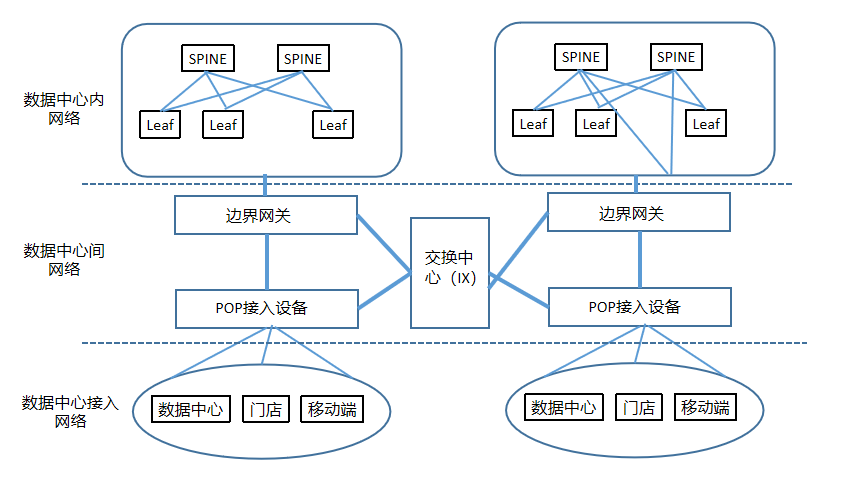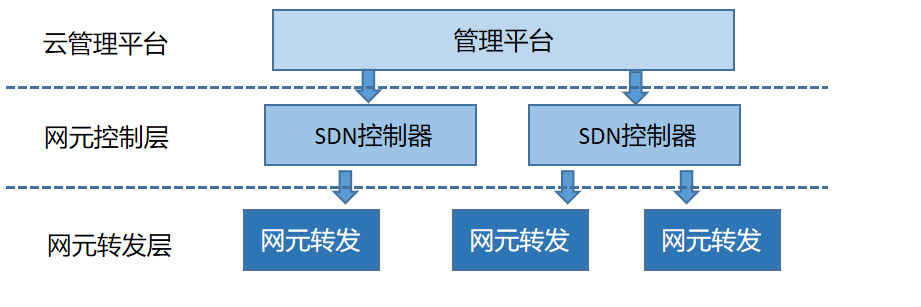Understand cloud network in one article

The digital transformation of enterprises has driven the development of cloud computing. According to statistics from the China Academy of Information and Communications Technology, my country's cloud computing market will experience explosive growth in 2020, with a growth rate of 56.6%. Enterprise cloud migration requires cloud computing resource delivery to be dynamic and on-demand. Cloud resources must have the characteristics of flexibility, nearby response, avoiding single cloud provider lock-in, and high reliability. This requires the network connecting cloud resources to have the ability to deliver quickly and be able to flexibly adjust according to business needs.

Operators have launched cloud-network integration services such as cloud private network, cloud private line, SD-WAN, etc., and strengthened the unified planning and construction of cloud network infrastructure. In collaboration with the big network, connection scenarios such as public cloud, private cloud, and hybrid cloud put forward higher requirements for cloud networks. Cloud networks must have cloud-network integration capabilities to meet new business requirements such as "one-point acceptance, automatic provisioning, unified operation and maintenance, and self-service on-demand".
In cloud computing scenarios, cloud networks need to efficiently carry three types of traffic:
- East-west traffic: traffic between servers in the data center to achieve intercommunication, migration, and synchronization of stored data between virtual machines;
- Cross-data center traffic: traffic between different data centers;
- North-South traffic: Traffic between access points or data sources outside the data center and servers inside the data center.
cloud computing network concept
Based on virtualization technology, cloud networks open up network capabilities and provide "cloud-edge-device" interconnection services for enterprises in the process of cloud migration and cloud use. A cloud network is a cloud-centric, application- and tenant-oriented virtualized network infrastructure that is on-demand, elastic, available anywhere, and measurable.
Cloud computing is a network service, a service network for enterprise tenants and applications. Compared with traditional networks, the typical characteristics of cloud networks are sharing, elasticity, self-service, on-demand, etc. To some extent, cloud network is the product of the fusion of CT and IT.
cloud network architecture

Figure 1: Cloud Network Architecture
Corresponding to the traffic in the cloud scenario, the cloud network is generally divided into three parts: intra-data center network, inter-data center network, and data center access network.
1. Network in the data center
The network in the data center mainly carries east-west traffic in the same data center to meet the high-speed access of resources such as servers. Generally, the two-layer spine-leaf architecture based on the CLOS architecture is adopted.
The foundation of the data center cloud network is the virtualization of network resources. Through the virtualization of network elements and network equipment, resources can be fully and flexibly shared. At the same time, network virtualization opens network capabilities, encapsulates various functions and resources into APIs and provides them to customers, so that customers can manage cloud, network, and terminal resources in a unified manner. In the data center cloud network, the 4-7 layer protocol network elements are generally implemented by NFV technology. Cloud networks provide network functions to tenants on the cloud through software virtualization.
The data center cloud network uses SDN to separate the control plane from the forwarding plane, making the control layer more flexible and the data forwarding layer more standardized. Through centralized control, network administrators can write programs through the API of the controller to realize automatic service deployment, greatly shorten the service deployment cycle, and realize dynamic adjustment on demand. The cloud network of the data center supports expansion by means of clusters, and combined with network virtualization, it provides elastic network for each user, and realizes the unified arrangement and control of the network.
Cloud networks employ technologies that optimize network addressing and improve network performance. Overlay technology is used in addressing. In terms of network performance, the data forwarding capability has been continuously improved by reconstructing the form of network equipment. The orchestration of cloud networks includes two aspects: (1) Virtualization of network functions: virtualize network functions through standard servers. According to the service requirements of cloud computing, it manages the life cycle of NFV network elements, dynamically creates, deletes, and expands NFV resources on demand, and issues corresponding forwarding entries or forwarding rules according to the service traffic model to ensure correct forwarding of service packets. (2) Virtualization of network services: The physical network is abstracted through the overlay technology, and multiple isolated virtual network services are provided to tenants, allowing different tenants to independently manage their own network environment.

Figure 2: Data Center Cloud Network Functional Architecture
The data center cloud network functional architecture includes three layers, from bottom to top, the network element forwarding layer, the network element management and control layer, and the cloud management platform (see Figure 2).
The network element forwarding layer is the base of the data center cloud network and provides network data plane functions. The forwarding layer is based on a general-purpose CPU, and completes the forwarding of network data packets through software programming; massive tenant isolation and multiplexing are realized through tunneling technologies such as VxLAN or NVGRE.
The network element management and control layer provides forwarding entries of the network element forwarding layer, and centrally processes the control plane of each network element. The network element control layer is independent of the network element forwarding plane. After the control layer generates the forwarding entry, it uniformly sends the forwarding entry to the data plane.
The cloud management platform provides functions such as network element orchestration, authentication, and accounting, manages the configuration of tenants’ different network elements and lifecycle events such as startup and deletion, delivers the configuration and events to the management and control layer, and updates the forwarding entries of the corresponding network elements , and finally provide different network connection capabilities according to business needs.
2. DCI (Data Center Interconnect Network)
The network between data centers carries the north-south traffic between different data centers, including the network between different data centers of the same cloud service provider and the network between data centers of different cloud service providers. The diversity of cloud computing services and the randomness of access require DCI to have the characteristics of service isolation and various access methods. There are usually three ways for DCI interconnection:
- One is the front-end network interconnection, also known as the network three-layer interconnection, and different data centers are interconnected through the front-end network (exit);
- The second is network layer 2 interconnection, which builds a large layer 2 interconnection network at the server network access layer in different data centers to meet the needs of server clusters or virtual machine dynamic migration scenarios;
- The third is the back-end network interconnection, which realizes the back-end storage network interconnection between data centers through technologies such as SAN, DWDH, and SDH.
From the realization level, DCI can be divided into backbone network and access network. The backbone network builds a dedicated forwarding plane, which is responsible for intelligent scheduling and fast forwarding of the entire network traffic. The access edge realizes the classified access and service differentiation of different services. The cloud's availability zone and the network egress architecture are loosely coupled, and each develops towards the optimal direction, forming an egress scheduling platform outside the cloud's availability zone.
The interconnection between data centers needs to solve the interconnection between multiple clouds and between multiple heterogeneous environments. MPLS VPN and SD-WAN are the key technologies for multi-cloud interconnection. MPLS VPN is isolated from the Internet link, featuring strong security and high link quality; SD-WAN manages the multi-cloud interconnection network uniformly through the controller, optimizes the quality of the underlying link, and can achieve low-cost, low-latency, high-availability cross-cloud Information transfer.
DCI is usually built by cloud service providers or by professional switching center manufacturers. In 2000, national-level Internet exchange centers and multiple regional-level exchange centers were established in Beijing, Shanghai, Guangzhou and other places; in 2015, Internet-based enterprise-based exchange centers began to appear. Starting from 2020, a new type of Internet exchange center will emerge, which will become the network foundation for my country's Internet innovation and development. The new Internet exchange center realizes indiscriminate access to various networks, making the interaction of information, data and resources more convenient.
3. Data center access network
The data center access network connects cloud resources and users. SDWAN technology is mostly used. By deploying CPE equipment or vCPE software that supports SDN centralized management and control at access points such as branches, resources can be flexibly allocated and self-service cloud resources can be realized. access. SDWAN binds multiple network lines according to business priorities, thereby reducing the overall networking cost on the basis of meeting business needs. At the same time, through the SDWAN programmable API, automated deployment can be achieved to control when and how the network is used.
Industrial Development
According to relevant research data from the China Academy of Information and Communications Technology, my country's cloud network service market represented by cloud dedicated lines, cloud networking, and SDWAN will reach 27.9 billion yuan in 2020. my country's cloud network industry is mainly composed of telecom operators, cloud service providers, and cloud connection service providers.
- Telecom operators productize network capabilities. With the advancement of 5G construction, telecom operators have huge advantages in edge cloud nodes, and can form cloud + network coverage from the core, bearer, and access to the entire link, and provide users with multi-level and diverse cloud network services.
- Cloud service providers adapt cloud services to the network environment. Cloud service providers build an open cooperation ecosystem with cloud as the core. Cloud connection service providers assist public cloud service providers to improve network capabilities.
- Cloud connection service providers open up network connections between multiple public clouds, forming a partnership model in which network resources and public cloud resources complement each other.
Cloud network development trend
With the development of technology and driven by the market, general-purpose computing forms have evolved from virtual machines to containers and function computing, and computing power has shifted from general-purpose computing to dedicated computing. Cloud networks are required to be able to carry computing tasks that require high performance. Lossless network and low-latency network have gradually become the foundation of cloud network basic network technology.
The market demand for edge computing is growing rapidly, and cloud-edge collaboration and distributed cloud have become new forms. The cloud-edge synergy network includes the network on the access side, the edge side, and the center side, and involves multiple virtualized software functional components of the data center access network, the inter-data center network, and the network within the data center.
As an optimal set of models for building cloud-based services, cloud-native networks are required to support cloud-native business requirements and meet the requirements for interoperability, security, and load balancing between network endpoints and services of cloud-native services. Cloud-native networks provide hierarchical services through service mesh + container network interface (CNI) (Container Network Interface). CNI implements the calling methods when creating and deleting containers, and ServiceMash encapsulates the network protocols of layers 4-7. With the support of cloud-native networks, cloud-native applications only need to pay attention to higher-level requirements such as service status, current limiting, and circuit breaker monitoring, and no longer need to pay attention to specific IP addresses and routing policies.
The next generation of cloud computing will be the distributed cloud (Gartner predicts). Distributed cloud requires the network to be edged and distributed. In the future, the cloud network should be able to realize the integration of business, cloud, and edge, and realize the integration and collaboration of cloud edge and cloud network. Cloud networks will gradually expand from central or regional clouds to end-to-end networks. Large-scale cloud exchange centers will form a new form of cloud-network collaboration, and realize multi-cloud resource access and multi-network interconnection between different regions, different cloud service providers, and different operators.
summary
Cloud networks unify cloud network resources and service capabilities, gradually break through the physical boundaries of cloud networks, and evolve to a technical architecture that integrates network, computing, and storage. The computing power network will be the next stage in the evolution of cloud networks.